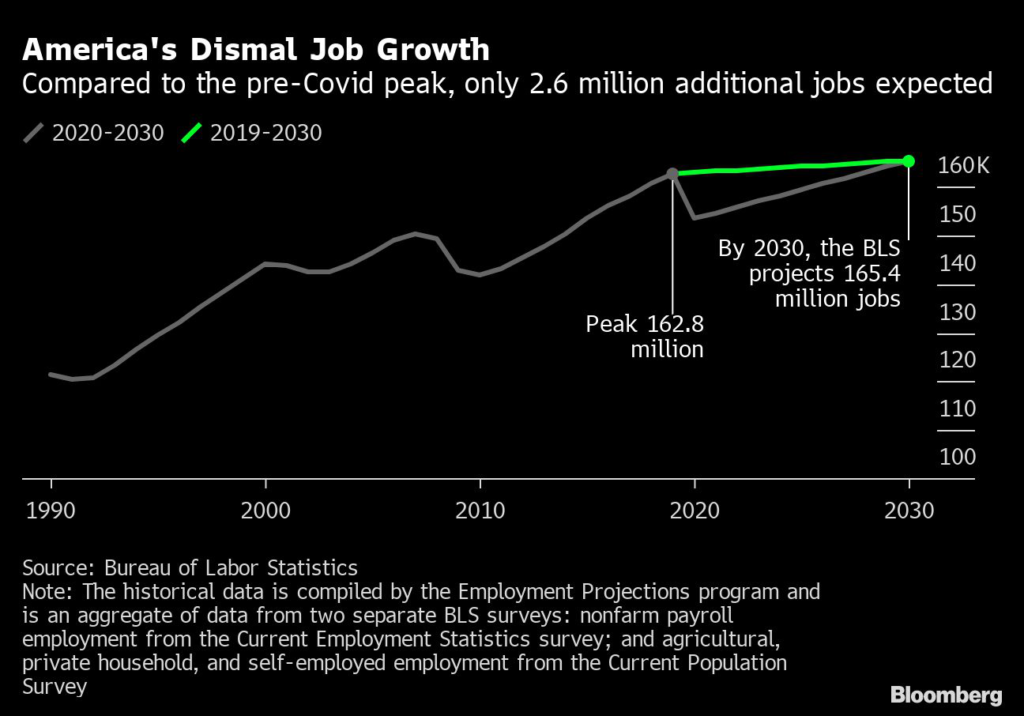(Bloomberg) — Sign up for the New Economy Daily newsletter, follow us @economics and subscribe to our podcast.
U.S. employment will see stunted growth during the remainder of the decade, with technology eliminating some roles and retiring Baby Boomers contributing to a drop-off in the share of Americans participating in the job market, according to federal government projections.
The U.S. will add 11.9 million jobs through 2030, according to a new analysis from the Bureau of Labor Statistics. The bulk of that, however, will simply reflect a recovery from the damage caused by the Covid-19 crisis. Compared with the 2019 pre-pandemic peak for the BLS’s series, the jobs gain will be just 2.6 million — weaker than in previous decades.
About one-third of the jobs created, or 3.9 million compared with the current baseline, will be in low-wage work — a part of the economy devastated by coronavirus-linked restrictions. That covers categories that pay less than $32,000 a year, or roughly $15 an hour.
BLS analysts also project that while economic growth will run at a faster average pace than previous years and worker productivity will increase, the country’s labor participation rate will decline as the workforce ages and fewer young people work.
The forecasts paint a picture of a U.S. economy relying on the very jobs that President Joe Biden’s administration vowed to improve for millions of low-income Americans.
Low-Wage Work
Total employment is projected to increase about 7.8% by 2030, to 165.4 million. That rise, which equates to just over 1 million added to payrolls each year, is about half the annual gain in the past decade, setting aside a decline during last year’s pandemic recession.
Low-wage sectors such as home health care are seen expanding, while the number of cooks, waiters and waitresses along with fast food counter workers — all jobs decimated during the pandemic — are expected to add almost 1.5 million jobs by 2030.
Fewer CEOs
The BLS sees 5.7% fewer chief executive officers by 2030, partly thanks to an increasing share of the economy being accounted for by larger companies — a concentration the Biden administration has been battling. Changing corporate organizational structures are also seen reducing the need for having separate CEOs for different units.
Retail is Still Dying…
After being hammered by a pandemic that kept people home, retail trade is projected to lose more than half a million jobs by 2030, the most of any sector. The crisis has served to deepen struggles already faced by brick-and-mortar retailers, competing with the ease and access of online shopping.
…So are Other Jobs
Many jobs with the fastest employment declines are in industries made obsolete by technology, with the need for watch repairers or typists fading. But others — including some that require advanced degrees — follow demographic trends. For example, by 2030 the BLS expects 2.1% fewer obstetricians and 1.8% fewer pediatricians as U.S. birth rates slow.
Some fields, such as compensation and benefits management, are expected to come under more pressure as capital substitutes labor. The BLS expects a decrease in these roles due to outsourced work or automation through specialized software.
More than half of the industries projected to have the most rapid declines are in manufacturing. The BLS expects global competition and the adoption of productivity-enhancing technologies, such as robotics, to continue to pressure U.S. factory employment.
Fewer People in the Labor Force
While employment is expected to expand to 165.4 million in 2030, the actual share of the population in the labor force will decline to 60.4% by the end of the decade from 61.7% in 2020. That’s largely a result of Baby Boomers retiring, a continuation of the declining trend in men’s participation and a slight drop in that for women.
Compared with a generation ago, the U.S. labor force is also expected to continue aging. By 2030, almost one in 10 workers are projected to be age 65 or older. And the average worker will be about 3 1/2 years older in 2030 versus 2000.
More stories like this are available on bloomberg.com
©2021 Bloomberg L.P.











